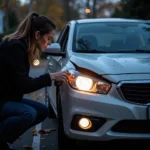Rust, the bane of any car owner’s existence, can quickly turn a minor blemish into a costly repair. But fear not, with the right car body repair kit rust can be tackled effectively, saving you both time and money. This comprehensive guide will walk you through everything you need to know about choosing and using a car body repair kit for rust, from identifying the type of rust to achieving a professional-looking finish. Let’s dive in!
Dealing with rust on your car can be a daunting task, but it doesn’t have to be. Car body repair kits specifically designed for rust removal and repair offer an accessible and effective solution. Understanding the different types of rust, choosing the correct kit, and following the proper application techniques are key to successful rust repair.
After identifying the rusted area, you’ll want to select the appropriate car body repair kit. Kits range from basic to comprehensive, offering various tools and materials for different levels of rust damage. Some include rust converters, fillers, primers, and paint, while others focus primarily on surface rust removal. Consider the severity of the rust and your DIY experience when selecting a kit. Check out car body repair in Southend for local assistance.
Types of Car Rust and Choosing the Right Kit
Not all rust is created equal. Surface rust appears as discoloration and can usually be addressed with a simple rust remover and some elbow grease. More severe rust, however, penetrates deeper into the metal and requires more extensive treatment. This may involve using a rust converter to chemically transform the rust into a stable compound before applying filler and paint.
Identifying Surface Rust
Surface rust often appears as orange or brown discoloration on the paint surface. It hasn’t yet penetrated the metal and can be treated relatively easily. A car body repair kit with a rust remover, sandpaper, and primer will usually suffice.
Tackling Deep Rust Penetration
Deep rust requires more aggressive treatment. Look for a car body repair kit that includes a rust converter, body filler, and potentially even fiberglass resin for larger holes. Remember, dealing with deep rust requires careful preparation and patience.
Step-by-Step Rust Repair Guide
Once you have the right kit, follow these steps for a successful repair:
- Clean the Area: Thoroughly clean the rusted area with soap and water, removing any loose rust, dirt, or debris.
- Remove Rust: Use a wire brush, sandpaper, or a rust remover included in your kit to remove the rust. For surface rust, this may be enough. For deeper rust, a rust converter is necessary. You may need car body repairs in Usk for professional help.
- Apply Rust Converter (if necessary): Apply the rust converter according to the manufacturer’s instructions. This converts the rust into a stable compound that can be painted over.
- Fill and Sand: If there are any holes or imperfections after rust removal, apply body filler and sand it smooth once dry.
- Prime and Paint: Apply primer to the repaired area, followed by several coats of matching paint. Allow each coat to dry thoroughly before applying the next.
- Protect the Finish: Apply a clear coat to protect the repaired area and enhance the finish.
Choosing the Right Tools and Materials
Your car body repair kit will likely include most of what you need. However, having a few extra tools on hand can make the process smoother. These may include:
- Safety Glasses and Gloves: Protect your eyes and skin from chemicals and debris.
- Masking Tape and Paper: Mask off surrounding areas to prevent accidental damage during the repair process.
- Sandpaper in Various Grits: For smoothing the repaired area before painting.
- Applicators: Brushes, rollers, or spray guns for applying the rust converter, primer, and paint. Car body fibreglass repair kit might be needed for extensive damage.
“A good quality car body repair kit is essential, but the right tools can make all the difference in achieving a professional finish,” says John Smith, Automotive Repair Specialist at Smith’s Auto Body. “Investing in quality sandpaper and applicators will ensure a smooth and even application, leading to a more durable and aesthetically pleasing result.”
Conclusion
Repairing rust on your car doesn’t have to be a daunting experience. With the right car body repair kit rust can be tackled effectively and affordably. By following the steps outlined in this guide and choosing the appropriate tools and materials, you can restore your car’s appearance and prevent further rust damage. Don’t hesitate to look at car body repair in Boscombe or car body rust repairs in Preston for further options.
FAQ
- What is the best car body repair kit for rust? The best kit depends on the severity of the rust. For surface rust, a simple kit with rust remover and primer will suffice. For deeper rust, choose a kit with a rust converter and body filler.
- Can I repair rust myself? Yes, with the right tools and materials, you can repair rust yourself.
- How long does a rust repair last? The longevity of a rust repair depends on the quality of the repair and the environment. A properly executed repair can last for several years.
- How do I prevent rust from returning? Regularly washing your car and applying a protective wax coating can help prevent rust.
- What are the different types of rust? Common types include surface rust, scale rust, and penetrating rust.
- Is it necessary to use a rust converter? A rust converter is necessary for deep rust as it chemically converts the rust into a paintable surface.
- What should I do if the rust is very extensive? For extensive rust damage, it’s best to consult a professional auto body repair shop.
Looking for other helpful articles? Consider reading about our services for car body repair in Boscombe.
Need help? Contact us via WhatsApp: +1(641)206-8880 or Email: [email protected]. Our customer service team is available 24/7.

